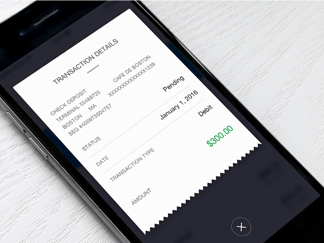Are E-Receipts Safe?
Retail Pedro Ramos
Pedro Ramos
.png?width=900&height=600&name=Untitled%20design%20(2).png)
Asking if we want a paper copy of our receipt is becoming the norm when we visit our favorite retailers and restaurants. Our first reaction is to say ‘no thanks’ to a paper copy. We think of the environment and convenience – and honestly, who really revisits those multitude of coffee shop reciepts cluttering our bags, wallets and pockets. Simply saying no to a paper copy is one less thing to recycle, fewer germs and extra protection from theft.
 When you consider buyer personas, Millennials and Gen Xers live by apps and cards so they prefer electronic receipts. Boomers are multichannel shoppers making purchases in department stores as well as shopping with the same retailers online. So, if you want to cater to the full range of generations and be competitive, you need to offer e-receipts.
When you consider buyer personas, Millennials and Gen Xers live by apps and cards so they prefer electronic receipts. Boomers are multichannel shoppers making purchases in department stores as well as shopping with the same retailers online. So, if you want to cater to the full range of generations and be competitive, you need to offer e-receipts.
Heather Petersen, CEO and Founder of National Merchants Association, a payment and transaction processor, advises, “If you don't plan on keeping your receipt, don't ask for it. It's better to not have it than throw it in the trash -- not only because it's not secure, but because it's a waste… According to some estimates, it takes approximately 9.6 million trees to create the 640,000 tons of paper that go into receipts each year. So, if you choose an emailed receipt or just hit "no receipt" when you pay at the pump, you'll be doing yourself a financial and environmental favor.”[i]
From the merchant’s perspective, e-receipts offer the means to expand the customer database with email subscribers, gather insights into buying behavior and engage with their customers beyond a single sale. Merchants can tailor promotions to customer interests, better understand customer buying patterns, offer rewards to frequent shoppers and engage with customers through mobile mediums.
So, what’s not to like? It seems like just ‘saying no’ to a paper reciept is a win-win all around. The merchant cuts down on paper and so does the customer – right?
Well, after taking a closer look from the merchant’s perspective, your reaction might be … ‘not so fast.’ There may be hidden dangers to this fast-growing trend that could have serious internal fraud, external theft and loss prevention consequences. Security is the main concern. You must increase monitoring efforts to maintain your own security and ensure you comply with the CAN-SPAM act which establishes requirements for commercial messages such as email, while protecting your customer’s financial and email security.
 When offering electronic receipts, retailers should review their merchandise return policy and processes. Same day e-receipt returns can leave a retailer vulnerable to fraud. Like their paper counterparts, e-receipts are easy to share, can be changed and are susceptible to forgery. Your loss prevention safety measures built around paper receipts won’t protect you nor your customers. Unlike paper, electronic receipts can be transmitted over a variety of devices instantaneously. This leaves your customers information vulverable while opening you’re the door to external fraud like refund scams. Furthermore, retailers could become targets of organized retail crime if customers share and alter e-reciepts. Often the altered e-receipt no longer reflects the original transaction.
When offering electronic receipts, retailers should review their merchandise return policy and processes. Same day e-receipt returns can leave a retailer vulnerable to fraud. Like their paper counterparts, e-receipts are easy to share, can be changed and are susceptible to forgery. Your loss prevention safety measures built around paper receipts won’t protect you nor your customers. Unlike paper, electronic receipts can be transmitted over a variety of devices instantaneously. This leaves your customers information vulverable while opening you’re the door to external fraud like refund scams. Furthermore, retailers could become targets of organized retail crime if customers share and alter e-reciepts. Often the altered e-receipt no longer reflects the original transaction.
Regardless of the format of the receipt, your safeguard against fraud should include an analysis of the customer’s entire purchase and return history to search for fraudulent behavior. Transaction logs generated by your POS provides valuable information. Find out who your customers are before you hand over that refund. Using software that combines data analytics together with loss prevention measures would allow retailers to uncover anomalies or unusual patterns of behavior at the POS or associate level.
Through the 20/20 Data Analytics™ platform, prescriptive alerts allow you to manage POS activities, , overtime budgets, employee performance and much more. Alerts can trigger warnings that can stop fraud in its tracks. Agilence has the solutions to help you increase profits, drive efficiencies and improve margins.
Want to say ‘no’ to receipt fraud and manipulation? Give us a call and we’ll show you how.
[i] CreditCard.com – Melody Warnick - 9 things you should know about your credit card receipt
Related Articles

Private Label Credit Cards for Retailers: How to Measure, Optimize, and Avoid Fraud
In the competitive retail landscape, private label credit cards (PLCCs) have emerged as a powerful tool to engage customers a...
Fighting Chargeback Fraud: Is there such a thing as Friendly Fraud?
Retailers are making it easier to return online purchases, issuing refunds before they receive the return goods. This policy ....png)
The LP Endgame: Using Data Analytics To Combat Fraud Schemes
While using analytics to combat fraud isn’t as dangerous as leveling the Infinity Stone-fueled powers of Thanos –anticipating...Subscribe to our blog
Receive free educational resources like exclusive reports, webinars, and industry thought leadership articles straight to your inbox.


